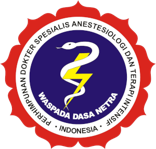Anesthesia Management in Patient with Placenta Percreta Performed Intra-aortic Ballooning Caesarean Section
Abstract
Placenta accreta spectrum is one of maternal mortality’s causes which is related with severe obstetric bleeding that requires hysterectomy. The incidence rate of the spectrum placenta increases with increasing caesarean section. Placenta accreta spectrum is also close-related to placenta previa. The aim of this study is to understand perioperative management in patient with placenta percreta performed with intra-aortic ballooning in caesarean section. We are following a case on a 36 year old female patient, multigravida at term pregnant with placenta percreta and history of caesarean section 5 and 2 years ago. The surgeries performed were caesarean section surgery as well as intra-aortic ballooning. Anesthetic technique used was general anesthesia. Operation duration approximately ± 180 minutes, bleeding 1500 cc. After the operation, the patient was admitted to the ICU. The patient going well and discharged from ICU to ward on the second day. After three days in ward, the patient discharged to home. Hemodynamic changes during balloon intra-aortic procedures are of particular concern to anesthetists. This is because the stopping of blood flow to the aorta in this case can cause an increase in blood vessel pressure, where the administration of nitroglycerin at low doses can reduce venous tone resulting in venous vasodilation which will maintain hemodynamic stability during the process of blocking blood vessels with a balloon. From the case we may conclude that anesthesia in pregnant women with placenta accreta spectrum should be carried out with caution and involve a multidisciplinary specialist given its high risk of bleeding. The intra-aortic balloon insertion technique can be an option used to reduce the risk of bleeding in patients with placenta accreta spectrum.
Keywords
Full Text:
PDFReferences
Cahill AG, Beigi R, Heine RP, Silver RM, Wax JR. Placenta Accreta Spectrum. Am J Obstet Gynecol [Internet]. 2018 Dec;219(6):B2–16. Available from: https://linkinghub.elsevier.com/retrieve/pii/S0002937818308925 2. Silver RM, Branch DW. Placenta Accreta Spectrum. Solomon CG, editor. N Engl J Med [Internet]. 2018 Apr 19;378(16):1529–36. Available from: http://www.nejm.org/doi/10.1056/NEJMcp1709324 3. Rajuddin R, Roziana R, Munawar M, Iqbal M. Management Placenta Percreta Succesfully With Total Abdominal Hysterectomy. A Case Review : AVERROUS J Kedokt dan Kesehat Malikussaleh [Internet]. 2019 Jul 25 [cited 2021 Mar 8];5(1):52. Available from: https://ojs.unimal.ac.id/index.php/averrous/article/view/1628 4. Purwoko R, Rusman M, Ridho A. Serial Kasus: Manajemen Anestesi pada Wanita Hamil dengan Plasenta Akreta yang Direncanakan Tindakan Seksio Sesarea [Internet]. Vol. 3, Jurnal Anestesi Obstetri Indonesia. 2020 [cited 2021 Mar 8]. p. 26–34. Available from: https://jurnalanestesiobstetri-indonesia.id/ojs/index.php/Obstetri/article/view/40 5. Blumenthal E, Rao R, Murphy A, Gornbein J, Hong R, Moriarty J, et al. Pilot Study of Intra-Aortic Balloon Occlusion to Limit Morbidity in Patients with Adherent Placentation Undergoing Caesarean Hysterectomy. Am J Perinatol Reports [Internet]. 2018 Apr 11;08(02):e57–63. Available from: http://www.thieme-connect.de/DOI/DOI?10.1055/s-0038-1641736 6. Silver RM. Abnormal Placentation. Obstet Gynecol [Internet]. 2015 Sep;126(3):654–68. Available from: https://journals.lww.com/00006250-201509000-00030 7. Reitman E, Devine PC, Laifer-Narin SL, Flood P. Case Scenario. Anesthesiology [Internet]. 2011 Oct;115(4):852–7. Available from: http://anesthesiology.pubs.asahq.org/article.aspx?volume=115&page=852 8. Luo F, Xie L, Xie P, Liu S, Zhu Y. Intraoperative aortic balloon occlusion in patients with placenta previa and/or placenta accreta: a retrospective study. Taiwan J Obstet Gynecol [Internet]. 2017 Apr 1 [cited 2021 Mar 8];56(2):147–52. Available from: https://pubmed.ncbi.nlm.nih.gov/284204
Refbacks
- There are currently no refbacks.








